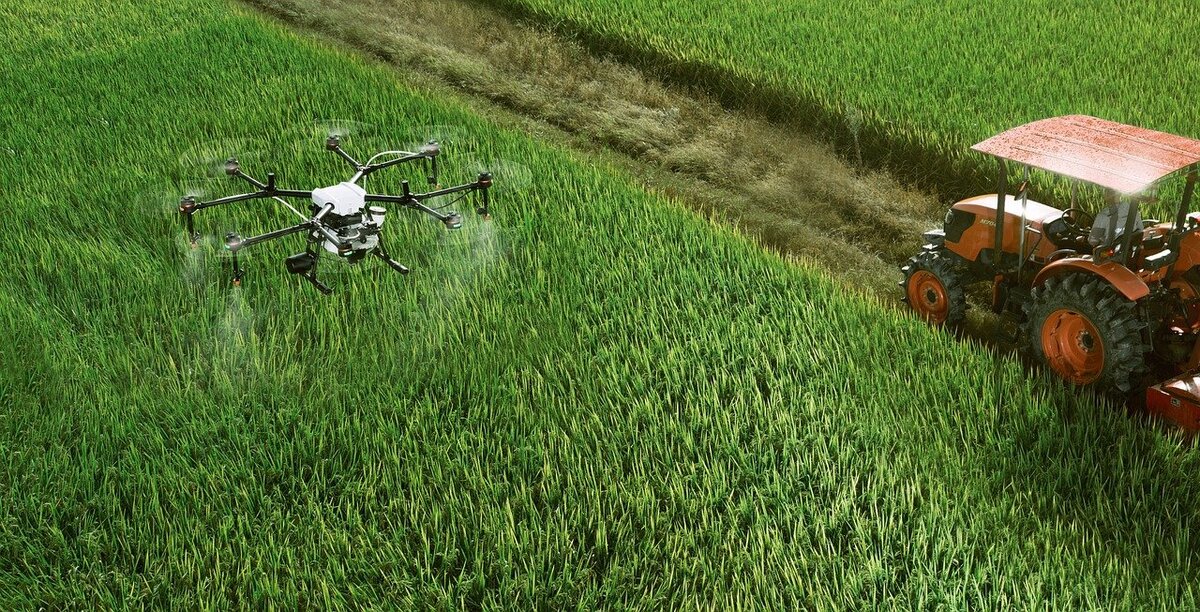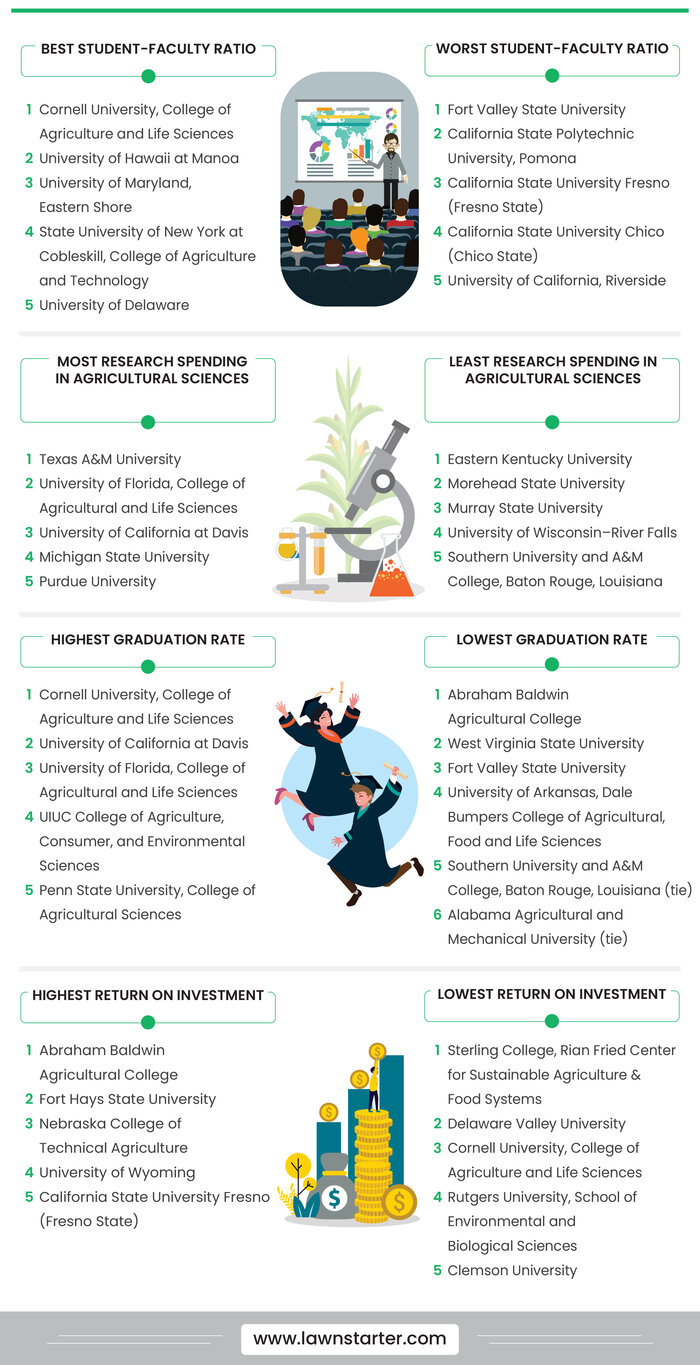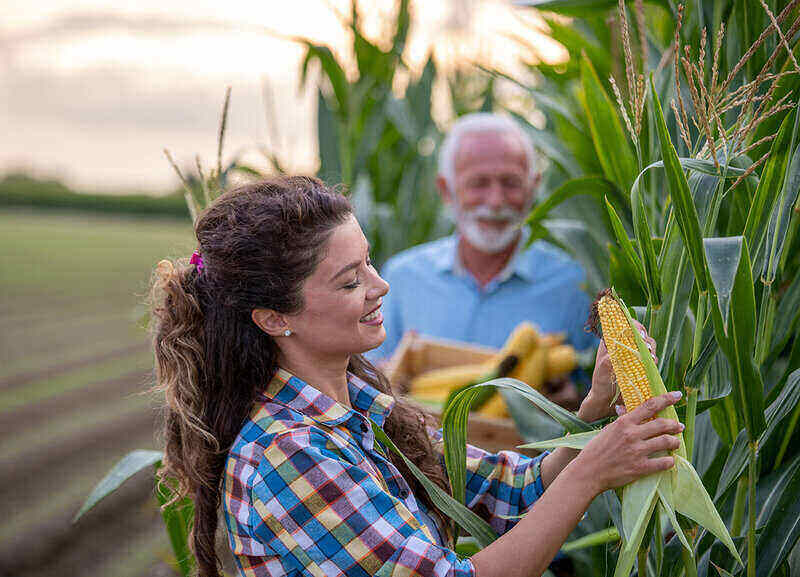
TV and movies often portray farming as a quiet and simple life: milking cows, feeding chickens, and tending to neat rows of vegetables planted by hand.
But that romantic vision couldn’t be further from reality: Today’s agriculture industry is meticulous, high-risk and intimately tied to global economics and politics. In a word, it’s complicated.
The farming industry is rapidly evolving to address 21st century challenges like a booming population and climate change. And with the onset of gene editing, drones and other high-tech solutions offering big opportunities, tomorrow’s agricultural professionals are guaranteed to look nothing like they do today.
No one knows exactly how agriculture will change in the next century — some researchers are betting on bugs as future crops! The best way to adapt to change is to be well prepared for the field, but not all schools are on the cutting edge of the new green revolution.
When choosing among agriculture programs, however, prospective students need to look beyond innovation. They must also consider a host of other factors, such as affordability, the level of personal attention from instructors and career potential.
To help future leaders of agriculture make the right decision, LawnStarter compared 76 colleges and universities with agricultural sciences programs across 12 key factors, demonstrating their selectivity, academic quality and value for money.
Which schools will grow the next generation of ag professionals to keep the rest of us well fed and growing, too? Read on for the results.
Table of Contents
Best and Worst Agricultural Schools Rankings
| RANK | University | SCORE | Admissions & Cost Rank | Academics Rank | Outcomes Rank |
|---|---|---|---|---|---|
| 1 | University of Florida College of Agricultural and Life Sciences | 71.9 | 8 | 1 | 2 |
| 2 | Texas A&M University | 67.89 | 11 | 2 | 15 |
| 3 | North Carolina State University College of Agriculture and Life Sciences | 63.12 | 15 | 4 | 14 |
| 4 | Purdue University | 60.12 | 14 | 5 | 17 |
| 5 | Michigan State University | 60.08 | 22 | 3 | 31 |
| 6 | University of Wisconsin–Madison | 57.98 | 3 | 16 | 11 |
| 7 | Iowa State University | 56.45 | 21 | 11 | 13 |
| 8 | Cornell University College of Agriculture and Life Sciences | 56.24 | 1 | 8 | 39 |
| 9 | Virginia Polytechnic Institute and State University | 55.15 | 12 | 12 | 25 |
| 10 | The Ohio State University | 54.9 | 5 | 24 | 12 |
| 11 | Penn State University College of Agricultural Sciences | 54.47 | 23 | 7 | 30 |
| 12 | University of California at Davis | 54.11 | 25 | 9 | 27 |
| 13 | University of Nebraska, Lincoln | 54.03 | 19 | 18 | 16 |
| 14 | UIUC College of Agriculture, Consumer, and Environmental Sciences | 53.44 | 4 | 22 | 23 |
| 15 | University of Georgia College of Agricultural and Environmental Sciences | 52.72 | 7 | 23 | 22 |
| 16 | University of Minnesota College of Food, Agricultural and Natural Resource Sciences | 52.7 | 6 | 20 | 38 |
| 17 | Washington State University | 52.66 | 51 | 6 | 44 |
| 18 | University of Arizona, College of Agriculture and Life Sciences | 50.99 | 33 | 10 | 57 |
| 19 | University of Missouri | 50.85 | 27 | 21 | 32 |
| 20 | Oregon State University | 50.63 | 29 | 14 | 56 |
| 21 | Mississippi State University | 50.63 | 40 | 17 | 33 |
| 22 | University of Kentucky College of Agriculture | 50.56 | 17 | 15 | 62 |
| 23 | Oklahoma State University | 49.52 | 38 | 19 | 43 |
| 24 | Auburn University | 48.93 | 16 | 30 | 24 |
| 25 | Utah State University | 48.1 | 32 | 27 | 36 |
| 26 | Kansas State University College of Agriculture | 47.8 | 68 | 13 | 20 |
| 27 | Colorado State University | 47.63 | 28 | 26 | 47 |
| 28 | University of Maine | 46.88 | 35 | 28 | 42 |
| 29 | South Dakota State University | 46.44 | 42 | 29 | 28 |
| 30 | University of Maryland, College Park | 46.29 | 2 | 49 | 19 |
| 31 | University of Wyoming | 45.17 | 24 | 51 | 5 |
| 32 | University of Arkansas, Dale Bumpers College of Agricultural, Food and Life Sciences | 45.13 | 26 | 25 | 71 |
| 33 | Texas Tech University | 44.83 | 45 | 31 | 29 |
| 34 | California Polytechnic State University | 44.35 | 20 | 55 | 8 |
| 35 | Stockbridge School of Agriculture | 44.19 | 9 | 41 | 49 |
| 36 | University of Hawaii at Manoa | 44.12 | 43 | 34 | 35 |
| 37 | Clemson University | 43.85 | 13 | 44 | 45 |
| 38 | Montana State University | 42.96 | 30 | 38 | 52 |
| 39 | University of Idaho | 42.84 | 51 | 36 | 37 |
| 40 | University of Delaware | 42.53 | 18 | 37 | 67 |
| 41 | North Dakota State University | 42.25 | 36 | 46 | 26 |
| 42 | Fort Hays State University | 42.11 | 58 | 47 | 4 |
| 43 | University of Massachusetts Amherst | 41.32 | 9 | 52 | 49 |
| 44 | Murray State University | 40.78 | 46 | 42 | 48 |
| 45 | University of Rhode Island College of the Environment and Life Sciences | 40.76 | 48 | 35 | 64 |
| 46 | University of California, Riverside | 40.26 | 39 | 58 | 18 |
| 47 | California State University Chico (Chico State) | 39.9 | 56 | 53 | 7 |
| 48 | Louisiana State University | 39.44 | 34 | 48 | 58 |
| 49 | University of Nevada, Reno | 39.37 | 37 | 62 | 9 |
| 50 | Rutgers University, School of Environmental and Biological Sciences | 38.96 | 65 | 33 | 51 |
| 51 | Abraham Baldwin Agricultural College | 38.34 | 64 | 67 | 1 |
| 52 | Nebraska College of Technical Agriculture | 37.95 | 66 | 54 | 10 |
| 53 | Southern Arkansas University | 37.69 | 54 | 39 | 63 |
| 54 | West Virginia University | 37.25 | 41 | 57 | 53 |
| 55 | Delaware Valley University | 35.66 | 55 | 32 | 76 |
| 56 | Morehead State University | 35.66 | 57 | 40 | 69 |
| 57 | New Mexico State University | 35.4 | 62 | 50 | 40 |
| 58 | Arizona State University | 35.23 | 31 | 63 | 41 |
| 59 | North Carolina Agricultural and Technical State University | 34.73 | 67 | 45 | 60 |
| 60 | California State University Fresno (Fresno State) | 33.91 | 71 | 68 | 3 |
| 61 | Arkansas State University | 33.89 | 50 | 60 | 55 |
| 62 | California State Polytechnic University, Pomona | 33.75 | 53 | 72 | 6 |
| 63 | University of Maryland, Eastern Shore | 32.75 | 75 | 43 | 59 |
| 64 | University of Wisconsin–River Falls | 31.72 | 59 | 66 | 21 |
| 65 | Missouri State University | 31.57 | 47 | 71 | 46 |
| 66 | Eastern Kentucky University | 30.95 | 49 | 64 | 65 |
| 67 | Western Kentucky University | 30.76 | 44 | 65 | 68 |
| 68 | Alcorn State University | 29.44 | 61 | 61 | 61 |
| 69 | State University of New York at Cobleskill College of Agriculture and Technology, Cobleskill, NY | 28.84 | 72 | 56 | 73 |
| 70 | Angelo State University | 26.44 | 63 | 69 | 66 |
| 71 | Florida A&M University | 25.72 | 76 | 59 | 34 |
| 72 | Alabama Agricultural and Mechanical University | 23.19 | 70 | 70 | 75 |
| 73 | Fort Valley State University | 21.64 | 73 | 74 | 54 |
| 74 | Southern University and A&M College, Baton Rouge, Louisiana | 21.32 | 74 | 73 | 70 |
| 75 | West Virginia State University | 19.49 | 60 | 75 | 74 |
| 76 | Sterling College Rian Fried Center for Sustainable Agriculture & Food Systems, Craftsbury Common, VT | 18.84 | 68 | 76 | 72 |

Key Takeaways
It isn’t called the Corn Belt for nothing
When it comes to a great agricultural sciences education, it’s hard to go wrong with America’s Heartland. Five of the top schools are from Midwestern states like Iowa, Wisconsin and Indiana, which also happened to be among 2019’s top 10 agricultural producing states by cash receipts. Where better to learn about the industry than where it’s a big part of daily life?
Bigger is better
Like any research- and tech-heavy field, agricultural science can be resource-intensive. So don’t be afraid to shoot for a large, flagship school. Eight of the top 20 schools in our ranking are also among the top 20 largest schools by attendance in the country. Sometimes it pays to go big.
The Gulf between us
The majority of our lowest-ranked agricultural sciences colleges are located in Gulf Coast states, while some schools bucked this trend — mostly in Texas and Florida. Each school should be considered individually, of course, but think twice before looking south.
East is least (valuable)
If you’re looking for a good return on investment, steer clear of New England and Mid-Atlantic states. While schools in Delaware or Vermont ranked well on education factors, their high tuition and low median salaries post-graduation leave much to be desired.
Ask The Experts
The study of Agricultural Sciences, like everything else, is undergoing rapid change. From drones monitoring crops to data driving harvests, Agricultural Sciences are getting an infusion of tech.
For insights on how the study of agricultural sciences is changing, we asked agricultural sciences educators these questions:
- Which agricultural science professions will have the highest demand in the next 5–10 years and why? Which ones offer the most potential for career growth?
- Considering the pandemic, what are the biggest challenges facing the agriculture industry, and how can agricultural science programs prepare students to address those challenges?
- How can agricultural science colleges adapt their teaching, practices, and professions to meet the long-term challenges posed by climate change?
- What are the three most important considerations for prospective agricultural science students when choosing the right school?
- Agriculture is not as popular as other majors. How can agricultural science colleges better attract prospective students, especially those from areas where agriculture is not a dominant industry? How can agricultural science colleges stay relevant
- Who should consider a post-graduate degree in agricultural sciences and why?





Which agricultural science professions will have the highest demand in the next 5–10 years and why? Which ones offer the most potential for career growth?
Agricultural science professions are driven by trends in the industry. One major trend that is driving employers’ hiring needs is the way in which agriculture is becoming increasingly a data and knowledge industry.
Plant improvement programs are being guided by data scientists working with plant breeders to synthesize the vast amounts of information being generated by widespread plant trials across contrasting environments.
Major ag companies that used to focus primarily on making things are now adding data-driven management recommendations to their product lines, as well as offering more agronomic advice for optimizing production from sub-field to landscape scales.
Coupling traditional career paths in agriculture (agronomist, crop protection specialist, certified crop advisor, plant breeder, etc.) with the ability to manage data and computer systems will help make students competitive in the changing job market.
In the UIUC Department of Crop Sciences, we are preparing students for this data-intensive future by giving them a solid foundation in the fundamentals of agriculture while helping them gain skills in data analysis.
Our Computer Science + Crop Sciences major emphasizes scientific computing skills for the agricultural sciences.
We are also developing an undergraduate concentration in Digital Agriculture for those students who want to focus more on agricultural production while building strength and understanding in the computing and statistics skills underlying advances in data science and artificial intelligence.
Considering the pandemic, what are the biggest challenges facing the agriculture industry, and how can agricultural science programs prepare students to address those challenges?
Maintaining contact with producers and communicating science and management recommendations remotely are a challenge during the pandemic.
Keeping supply chains moving is also a challenge.
Training students to learn and communicate remotely, while continuing to learn the fundamentals of crop sciences will prepare them to address these challenges.
How can agricultural science colleges adapt their teaching, practices, and professions to meet the long-term challenges posed by climate change?
Creating robust solutions to addressing the long-term challenges posed by climate change requires a multi-disciplinary approach to research, education and extension.
At the University of Illinois, our research in the plant, soil and atmospheric sciences takes place along a continuum from basic discovery to applications for production systems to mitigate and adapt to climate change.
Our students receive instruction on the science underlying global change and best management practices to help crop production systems adapt to and mitigate it. They also have abundant opportunities to participate in research addressing climate change.
What are the three most important considerations for prospective agricultural science students when choosing the right school?
- Great faculty who are leaders in their field: who you train with has implications for the professional and scientific network that you build as the base for your career.
- Opportunities for experiential education: As students transition from high school to college, the importance of having access to opportunities for hands-on learning opportunities can’t be overstated.Clubs, internships and research assistant opportunities allow students to deeply assimilate the concepts they’ve learned and deepen their understanding and skills far beyond what can be accomplished in the classroom.
- Welcoming, warm learning environment: It’s important to feel comfortable in your home department. A warm, encouraging environment can go a long way toward supporting student success.
Agriculture is not as popular as other majors. How can agricultural science colleges better attract prospective students, especially those from areas where agriculture is not a dominant industry? How can agricultural science colleges stay relevant?
It remains a mystery to me why agriculture is not one of the most popular majors on campus. For students who love the natural sciences and are interested in doing something to help society and the planet, agriculture is an excellent fit.
I grew up in an urban environment, loved plants and nature and didn’t understand that agriculture could be a career for me until my last year of college, when I saw a flyer for an agriculture internship on a bulletin board in the library I was studying in. I applied, loved it, and found my way home.
There are many students like this in urban and suburban environments — reaching out to them early, with a hopeful message that they can be helpful and make a difference, can help agricultural science colleges stay relevant.
Who should consider a post-graduate degree in agricultural sciences and why?
Students who want to deepen their knowledge, skills and experience in the agricultural plant sciences may find graduate school exciting.
There are numerous career paths leading out of graduate school in crop sciences (industry, academia, government research labs, policy, finance, non-profits), and a student’s career interests will determine which approach to graduate school makes the most sense for them.
Students wishing to obtain a graduate degree quickly before entering the job market should consider a 4+1 program, such as the one offered by UIUC Crop Sciences (5th year allows them to earn B.S. and M.S. at same time).
For agricultural professionals working directly with producers (e.g., CCAs, coop agronomists, industry professionals), a Professional Science Masters or online MS program can allow them to keep working while increasing their earning potential within their organization.
For students wishing to embark on a research career, a traditional M.S. or Ph.D. program offers a more intensive learning environment.

Which agricultural science professions will have the highest demand in the next 5–10 years and why? Which ones offer the most potential for career growth?
Engineering: Anything related to precision agriculture (e.g,, drone technology, GPS-guided crop sensing/monitoring, robotic pruning, irrigation, spray application, harvest).
Horticulture/Genetics: crop breeding for variety selection, pest/disease resistance, drought tolerance, etc.
Applied Crop Protection/Ecology (Entomology, Plant Pathology, Weed Science): invasive species biology, biological control, biologicals-based crop protectants.
Considering the pandemic, what are the biggest challenges facing the agriculture industry, and how can agricultural science programs prepare students to address those challenges?
Challenges: Management and safety of migrant labor force; marketing versatility in observance of pandemic guidelines.
What are the three most important considerations for prospective agricultural science students when choosing the right school?
1. Access to solid preparatory course offerings – with labs (I’m assuming this refers to undergrad students): chemistry, biology, genetics, biochemistry. If possible, options in entomology, weed science, plant path, horticulture, agronomy, natural resources. Also, Spanish language training.
2. Faculty with active applied research programs.
3. Even better: at least some faculty with Extension appointments.
Agriculture is not as popular as other majors. How can agricultural science colleges better attract prospective students, especially those from areas where agriculture is not a dominant industry? How can agricultural science colleges stay relevant?
Institute summer REU (Research Experience for Undergraduates) programs, faculty internship/mentoring programs, departmental open houses (e.g., during homecoming weekends); encourage faculty to explore Citizen Science research opportunities as a way of promoting visibility; look into adjunct faculty status with departments at nearby land grant institutions.
Who should consider a post-graduate degree in agricultural sciences and why?
Students not committed to the big 4-5 career paths — business, law, medicine, IT, engineering — and who have an interest in the natural sciences, should be made aware of the advances occurring in the agricultural sciences, and how specializations in areas like genetics/genomics, microbiology, botany, chemistry, can be a natural fit in relation to ag sciences.
Similarly, this field can be an appropriate career entry point for graduates of community colleges/associate’s degree holders looking to apply their training to programs with an active need for people with related background coursework.

1. Which agricultural science professions will have the highest demand in the next 5–10 years and why? Which ones offer the most potential for career growth?
Highest demand: agricultural sales, plant scientists. Highest potential for career growth: plant sciences
Considering the pandemic, what are the biggest challenges facing the agriculture industry, and how can agricultural science programs prepare students to address those challenges?
Biggest challenges: connecting with stakeholders without overwhelming them. Our students are presently consuming courses and videos, but have less experience delivering or initiating virtual contact with stakeholders.
All agriculturists also need to understand the food supply chain and how climate and disease outbreaks impact the food chain. Inclusion, diversity, and equity in agriculture are and will continue to be major challenges.
Agriculture relies upon a large and relatively inexpensive labor force which presents social challenges. Consumers appear to be willing to pay more for their food if they know it is justly sourced and produced.
2. How can agricultural science colleges adapt their teaching, practices, and professions to meet the long-term challenges posed by climate change?
Colleges of agriculture need to continue to address and integrate climate change science in all of their courses. Climate change is real and impacts agriculture.
More needs to be done to address water shortage, increasing temperatures, modifications of growing seasons, and increased pest pressures.
3. What are the three most important considerations for prospective agricultural science students when choosing the right school?
Reputation of the faculty, networking potential among students and faculty, and opportunities for international work and diverse experiences.
Agriculture is not as popular as other majors. How can agricultural science colleges better attract prospective students, especially those from areas where agriculture is not a dominant industry? How can agricultural science colleges stay relevant?
Agriculture is relevant to everyone. We need to look at major urban centers, like Raleigh, North Carolina, a town of 1M+ people with agriculture being taught in 15/29 public high schools and five middle schools with 32 teachers and some 7,000 students.
All schools have greenhouses, are engaged in the community, and many have animals on the campus. These programs feed a lot of students into colleges of agriculture.
Still, many students simply don’t know about the opportunities in agriculture and both they and their parents view agriculture as it was in the 1940s.
When I share about some of the technologies in agriculture with prospective students and parents, the parents are the ones who are amazed because today’s agriculture is not like their grandparents’ farms.
Who should consider a post-graduate degree in agricultural sciences and why?
People passionate about food, stewardship, and sustainability should consider post-graduate studies in agriculture.
From this day forward, every day of our lives will include more focus on the importance of solving challenges related to food, the environment, and sustainability than the day before.

1. Which agricultural science professions will have the highest demand in the next 5–10 years and why? Which ones offer the most potential for career growth?
We have recently seen an uptick in positions in urban horticulture and controlled environment agriculture professors and associated positions. I think this will continue to grow as urban production centers become more financially viable and the trend toward local food and production grows.
There are many other positions and professions in ag that will be available in the next 5-10 years though. We already can’t meet the demand for employees to fill positions in the food, agriculture and natural resource sciences, and that gap is expected to increase by 2026.
So, I believe that there will be many opportunities in many fields within the scope of agriculture.
2. Considering the pandemic, what are the biggest challenges facing the agriculture industry, and how can agricultural science programs prepare students to address those challenges?
There are many challenges facing the agriculture industry.
Plants don’t understand there is a pandemic, they don’t stop growing and needing care but there are more limitations on providing the care.
The new FSMA laws have prepared the industry for protecting consumers from diseases and pathogens which is great news. However, there will always be a need to fully understand the dynamics of pathogens and how they impact food safety.
I think that focusing on increasing knowledge of food safety practices, technology, and how to produce food with fewer human resources may be beneficial in times like these.
Yet there still must be a balance for those whose livelihoods depend on agriculture and training them to use these advancements so they don’t become obsolete.
2. How can agricultural science colleges adapt their teaching, practices, and professions to meet the long-term challenges posed by climate change?
I think that we are doing a better job of teaching climate change now that we know more about it and what it involves.
The impacts are being felt in rainy season changes, changes in planting dates, late or early freezes, droughts, etc.
As long as we are aware of these effects and physically demonstrate how agriculture has been impacted by climate change I think that we can be better teachers. This will, in turn, benefit the future scientists we teach and how they approach climate change solutions.
3. What are the three most important considerations for prospective agricultural science students when choosing the right school?
Look at the curriculum, hands-on or experiential learning opportunities like internships or labs, and the majors offered. There are many excellent agriculture programs out there so finding one that suits your career and education goals will just take some research.
4. Agriculture is not as popular as other majors. How can agricultural science colleges better attract prospective students, especially those from areas where agriculture is not a dominant industry? How can agricultural science colleges stay relevant?
I think the historic image of agriculture has attributed to this. While it isn’t a bad image and there is nothing wrong with how it has been portrayed, agriculture has been seen primarily as farming and few look beyond that description to see the many other applications and sciences involved.
Agriculture is so diverse and requires knowledge in so many subjects that it can appeal to many people.
I think that agriculture science colleges can better attract prospective students by demonstrating the diverse careers and learning opportunities associated with agriculture.
But in the end we need to adapt to the needs and interests of students. Surveying students or prospective students, working with high schools to instill interest, being involved with urban communities, and other methods can help agriculture colleges remain relevant.
5. Who should consider a post-graduate degree in agricultural sciences and why?
I think there are three main things to think about when considering a post-graduate degree: 1) do you feel like you have the knowledge and training to get you where you want to be in your career?, 2) does the career you want require additional education?, and 3) are you changing the course of your career?
While there are many reasons to get a post-graduate degree these are typically what I see as the most applicable to the graduate students I work with. But in the end, if you have the passion to learn more, it will advance your career, or you want to change your career it will benefit you.
Methodology
To design our ranking of 2021’s Best Colleges and Universities for Agricultural Sciences, LawnStarter first determined three key categories — Admissions, Academics and Outcomes — that prospective undergraduate students consider most heavily, among other factors, when comparing schools.
Across the three key categories, we then compiled 12 related metrics using the most recently available data. (All data are from 2020, unless otherwise noted.) The categories and their corresponding metrics are listed below with the score we assigned to each.
Due to the uncertainty imposed by the coronavirus pandemic on higher education institutions, we assigned a medium weight (7 points) to the Virtual Learning Opportunities metric to emphasize the need for flexibility in the classroom. Not all U.S. colleges and universities that have reopened this fall semester are fully remote, and more than a quarter of college students prefer online-only learning at this time, according to a recent poll.
We then added up the scores across all categories for each of 76 colleges and universities with agricultural sciences programs to arrive at the final ranking, which is based on their overall scores. The highest possible score is 100 and corresponds with a rank of No. 1, or “best,” while the school with the lowest score was ranked No. 76, or “worst.”
Admissions (Total Points: 26)
- Acceptance Rate: 5 points
- Scholarship Availability: 7 points
- Median SAT Score: 7 points
- Median ACT Score: 7 points
Academics (Total Points: 44)
- Research Spending: 10 points
Note: Measures total expenditures on agricultural sciences research (data from 2018) - Personal Attention: 10 points
Note: Measures student-faculty ratio - Program Variety: 7 points
Note: Measures number of agricultural departments - Virtual Learning Opportunities: 7 points
Note: Measures online degrees and courses in agricultural sciences - Program Completions: 5 points
Note: Measures number of bachelor’s degrees in agricultural sciences-related majors awarded in 2018–2019 academic year - Advanced Education Opportunities: 5 points
Note: Measures post-graduate agricultural sciences programs
Outcomes (Total Points: 30)
- Graduation Rate: 10 points
Note: Data from 2018 - Return on Investment: 20 Points
Note: Measures median salary of agriculture graduate with a bachelor’s degree divided by tuition and fees
Sources: Each college or university website, National Center for Education Statistics, National Center for Science and Engineering Statistics, U.S. Department of Education’s College Scorecard, and U.S. News & World Report.
Main Photo Credit: DJI-Agras / Pixabay




